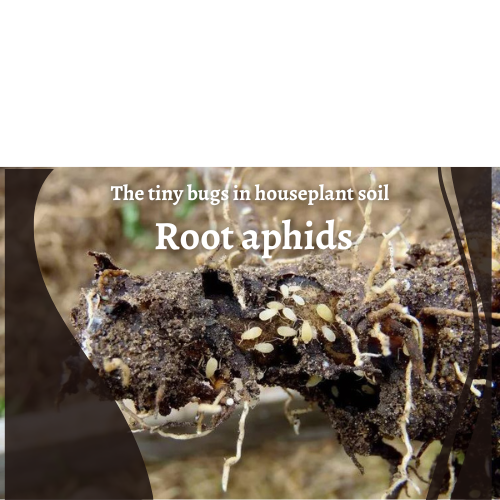In this article I want to talk with you about one of the most common tiny bugs in the soil of your houseplant: Root Aphids; If they are your annoying guest, join me in this article to tell you:
- What do root aphids look like?
- What are root aphids’ symptoms and damages?
- Where do root aphids come from?
- Root aphids or soil mites?
- What is a root aphid’s life cycle in your houseplant’s soil?
- What temperature kills root aphids?
- What kills root aphids best and how to get rid of it?
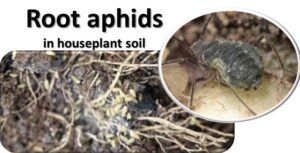
If you haven’t identified the exact culprits in the soil of houseplant, please first read “The 6 common tiny bugs in houseplant soil”.
In addition, besides root aphids, the other tiny bugs that you may spot in your houseplant’s soil are the following bugs. If you have any problem with each one, please click on it to know more:
- Isopods (Pill bugs)
- Springtails
- Mealybugs (Scales)
- Fungus gnats
- Earwigs
Because root aphids live inside the soil, you may not spot them easily, hence, in the following, first I will tell you about the symptoms of the infected plant and then show you the appearance of its culprits. You should grab your magnifying glass.
Before starting, I will walk with you through this article and feel free to ask your questions below this page, I will answer them as soon as possible. let’s get going to give you a brief overview of root aphids inside your houseplant’s soil.
| ➡ You can here to the audio version of “Where Do Root Aphids Come From in Houseplants?”
|
Signs of root aphids in your houseplant and their damages
You may find your houseplant with Withered, curled, and yellow leaves with a lack of vigour like a sign of nutrient deficiencies. In this situation, your houseplant fails to reach the size of healthy plants. If you spot these symptoms that don’t improve by adding certain minerals, usually magnesium and other fertilizers, you have to check the roots of your plant; there is the risk of the root aphid’s infestation.
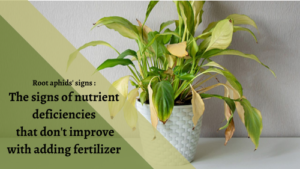
The root aphid will kill your houseplant if you don’t detect it early. In addition, your plant will be very vulnerable to root rot, mildew, and other root disease. Hence you must remove your houseplant from the pot and check the roots.

If you see 2-3mm long bugs with pear-like bodies and white, yellow, green or brown colour, your houseplant is infected by root aphid. Also, you may see waxy white secretions on the roots.
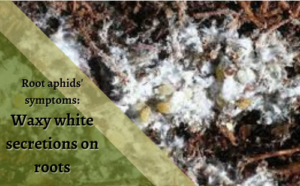
In this situation, you may be confused between root aphids and mealybugs. So, you must spot the bugs with your magnifying glass. Please read about “Root Mealybugs (scales) in houseplant soil.”
Another symptom of root aphid infection is the presence of ants around your houseplant. Ants are the close friends of aphids. They feed on the honeydew secreted by aphids. Instead, during the spring and summer, ants carry the aphids from one houseplant’s pot to another and protect aphid eggs from overwintering.
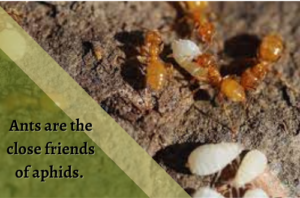
Root aphids or soil mites?
To distinguish between root aphids and soil mites please grab your magnifying glass. As you can see in the following picture:
- Soil mites have eight legs but root aphids have six
- Soil mites are smaller than root aphids.
- Root aphid is more common on the roots near the soil surface.

Where do root aphids come from?
Although there are both winged and wingless root aphid forms, in comparison with foliar aphids, root aphids move very slowly. If you have an infested potted plant, it can spread among other plants by:
- Carried by ants from one indoor plant to another plant.
- Buying an infested houseplant.
- Moving to another plant through the water passing through drainage holes in pots
- Spread among other plants by draining water from one pot to another.
- Some of them are winged and may come on topsoil and move to other close plants.
What is root aphids’ life cycle in your houseplant’s soil?
Since the look of root aphids varies in different stages of their life cycle, you should know about it. In addition, having information about its life cycle may help you to control it better. To make it easy for you, I try to explain it by picture.
As you can see in the following infographic, the root aphids’ life cycle consists of three stages: The nymphs, wingless adults and winged adults.
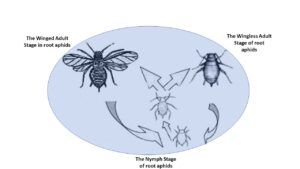
1- The Nymph Stage of root aphids
The nymphs are the newborn people. You can see the appearance of root aphids’ nymphs in the following picture. They are about 0.1 t0 0.2 cm (0.04 to 0.08 inches) with 6 to 8 legs. Please grab your magnifying glass.
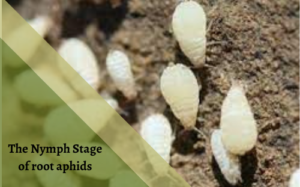
The nymphs’ hangout is the roots of your houseplant and feed on them by sucking its sap. It often takes 9-10 days for root aphid’s nymphs to mature depending on the species.
Be careful, although they are slow crawlers, as mentioned earlier, they can rapidly move to other indoor plants by water that is drained from holes in the pot, and your gardening equipment like an infested shovel.
2- The Wingless Adult Stage of root aphids
Finally, the nymphs convert to wingless adults on the root of your houseplant. As you can see in the following image, they are usually up to 0.3 cm (0.12 inches). You can spot them in various colours including white, yellow, green or brown.
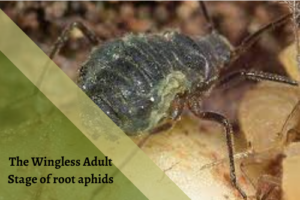
Their lifespan is about 30 days depending on the species. During it, the female wingless adults reproduce asexually and give birth to their genetically similar daughters.
The wonderful thing about them is that they can double their population every 1.5 days. It can be very dangerous for your houseplant if you fail to identify root aphid infestation early enough!
3- The Winged Adult Stage in root aphid
Often after increasing the population, death of plants or other situations that cause a shortage in food sources, the wings will develop in some root aphids. They come on the soil surface and migrate from one plant to another. You can see the winged adult root aphid in the following picture.
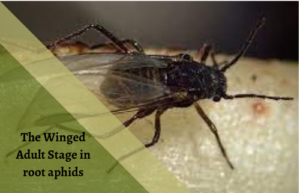
Some gardeners get confused between winged root aphids and fungus gnats. Let’s get going to know their difference.
- The winged root aphids fly higher and farther to migrate to a new host they often fly straight towards the lights but fungus gnats fly around your plant.
- The winged root aphid is slimmer than the fungus gnat. You can compare their appearance in the following picture.
What temperature kills root aphids?
The optimum temperature range for root aphids is between 20-25 C (68˚-77˚F). Research shows that they will kill in temperatures between -5 to -15 ˚C (23 to 5 ˚F) and higher than 32 ˚C (90 ˚F).
Hence, in outdoor plants, aphids are more active during spring and fall but in houseplants, aphids can be active overall the year.
How to get rid of root aphids in the soil of the houseplant?
In the following, you will find 6 practical ways to control root aphids in your houseplant’s soil. First, watch a video about it.
1- Eradicating the infested plant.
You may think it is a crazy way but if you didn’t notice root aphids on time and there has been a severe infestation, eradicating the infected plant is the best way to protect other plants from root aphid infestation.
2- Neem oil can help you to treat the roots.
In minor infestations, Neem oil is a good organic and effective home pesticide. Click to tell you how to make and use neem oil.
3- Using a pyrethrum root aphid spray.
Pyrethrum is another organic and effective pest killer, that you can buy or make at home. You should spray it on the soil and then water lightly to spread it inside the ground. Aphids are often more active in the morning. Hence the best time to spray them is early morning.
Apply this pesticide every two weeks until you find out that the aphid’s infestation signs have disappeared and your plant has got vigour again.
4- Yellow sticky papers.
They also can trap a few aphids that are moving inside the soil if you put them on the soil of your houseplant. You can buy “Yellow sticky papers” or make them a homemade one, click here to tell you how to do it.
5- Get help from your gardening friends
Root aphid predators such as ladybugs and Parasitic wasps. You can buy them and other beneficial insects.
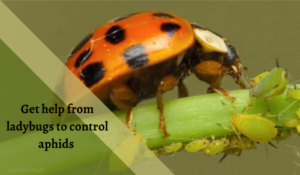
6- Check every houseplant before buying it.
To make sure the new houseplants have been not infested by root aphids, you must notice plant vigour and its soil. check them before bringing them to your home.
7- Soil drench for root aphid
Although I often don’t recommend using chemical pesticides inside the house if you need to know, applying imidacloprid or dinotefuran as a soil drench is an efficient way to control root aphids. These insecticides are absorbed by the roots and hence they can kill aphids after sucking the root sap.
Conclusion
Now you can detect an infested plant to root aphids and know how to get rid of them. Have you ever had any experience with this pest? Did you control it? Do you think which one of our treatments is more effective? Do you have a unique way to get rid of root aphids? Please share your experience and ideas with us below this page.
If you have any problem with root aphids in your houseplant yet, please ask your question below this page.

Elahe Rabiei
Hi, I’m Elaheh. My Academic major is plant protection, and houseplants are my expertise. As a houseplant lover, my house is full of indoor plants and it is my passion to take care of them. Hence, I’m here to share my knowledge and experience about growing healthy houseplants. I am also a plant protection advisor, so feel free to ask me any questions you may have.

